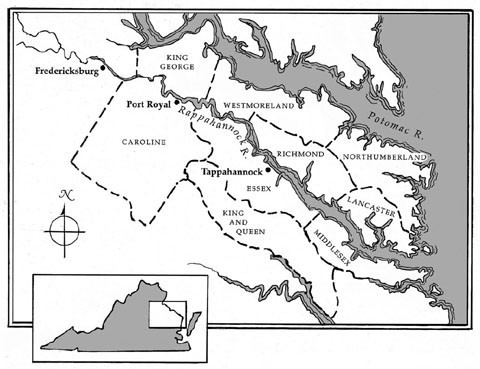
Map of the lower Rappahannock River basin.
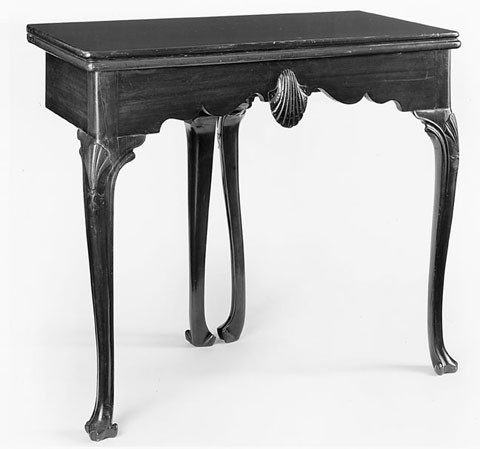
Card table, Ireland, ca. 1760. Mahogany with deal. H. 29", W. 33", D. 17 1/2". (Courtesy, Malahide Castle, Ron and Doreen McDonnell Collection; photo, Gavin Ashworth.)
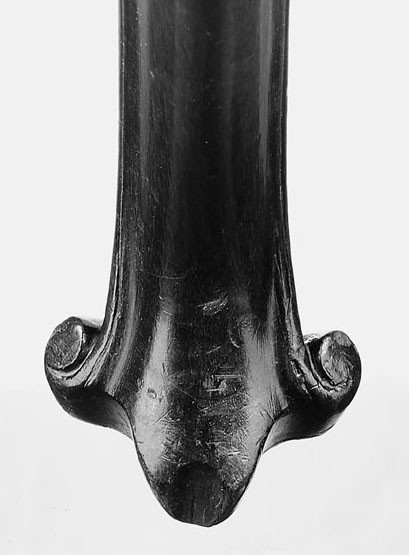
Detail of a foot on the card table illustrated in fig. 2. (Photo, Gavin Ashworth.)
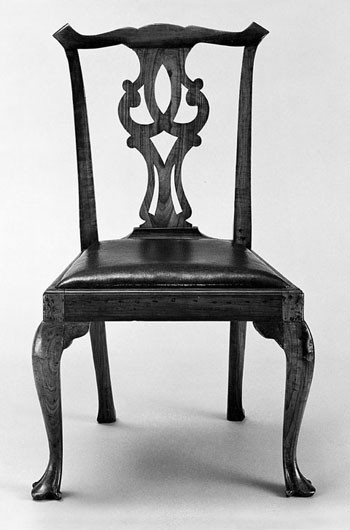
Side chair, lower Rappahannock River basin, Virginia, 1760–1775. Cherry. H. 37 3/8", W. 21 1/2", D. 17 3/4". (Private collection; photo, Hans Lorenz.)
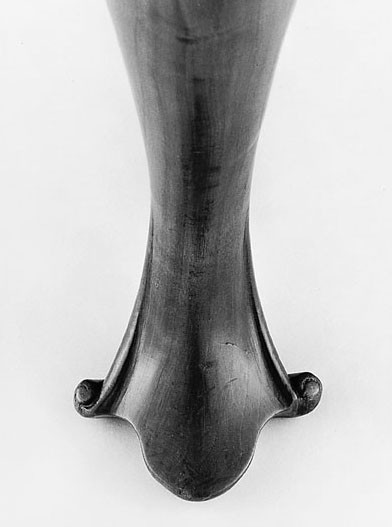
Detail of a foot on the side chair illustrated in fig. 4.
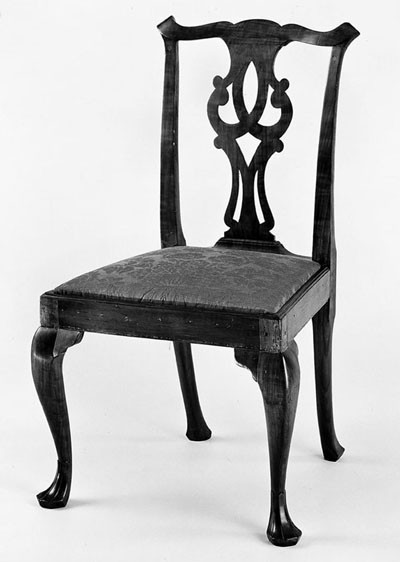
Side chair, lower Rappahannock River basin, Virginia, 1760–1775. Cherry. H. 37 1/2", W. 21 1/2", D. 18". (Private collection; photo, Hans Lorenz.)

Detail of a foot on the side chair illustrated in fig. 6.
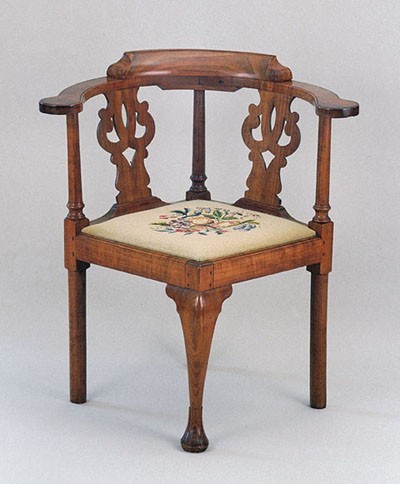
Corner chair, lower Rappahannock River basin, Virginia, 1760–1775. Cherry with yellow pine. H. 35 5/8". (Private collection; photo, Hans Lorenz.)
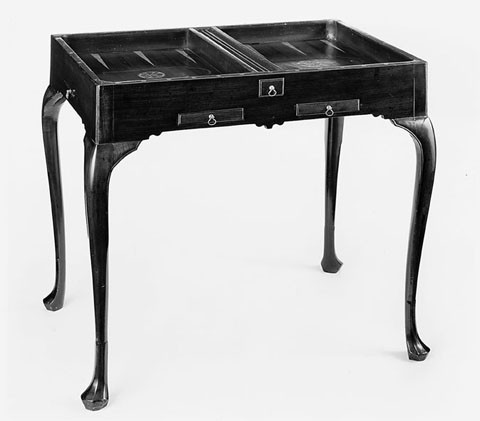
Game table, Ireland, ca. 1750. Mahogany with deal and oak. H. 27", W. 31", D. 21 3/8". (Courtesy, Glin Castle Collection; photo, Gavin Ashworth.) The table is shown without its reversable top.
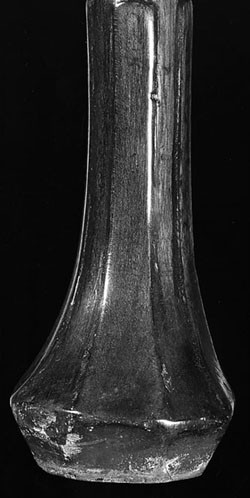
Detail of a foot on the game table illustrated in fig. 9. (Photo, Gavin Ashworth.)
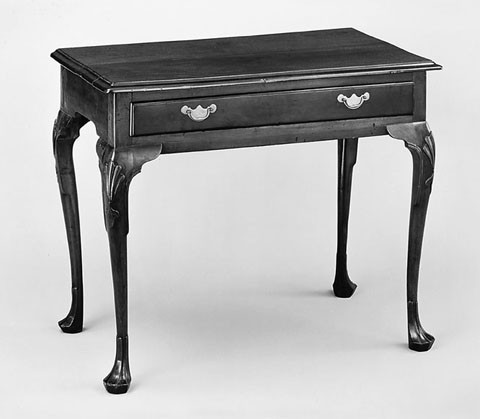
Writing or dressing table, lower Rappahannock River basin, Virginia, 1760–1775. Cherry with yellow pine. H. 28 3/8", W. 35 1/4", D. 19 1/2". (Courtesy, Colonial Williamsburg Foundation; photo, Hans Lorenz.)
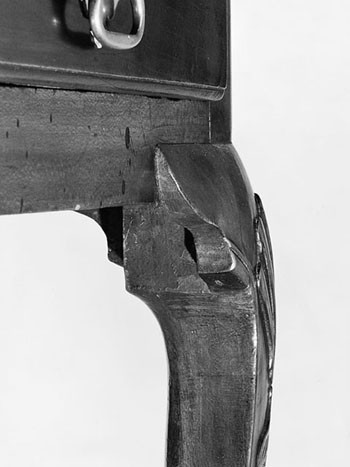
Detail of a knee block from the table illustrated in fig. 11.

Tea table with drawer, Ireland, 1750–1765. Mahogany with deal and oak. H. 28 5/8", W. 32", D. 20 3/8". (Courtesy, Colonial Williamsburg Foundation; photo, Hans Lorenz.)
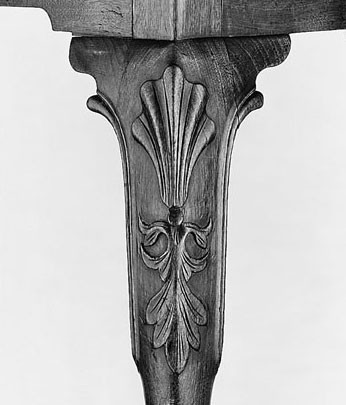
Detail of a carved knee from the table illustrated in fig. 13.
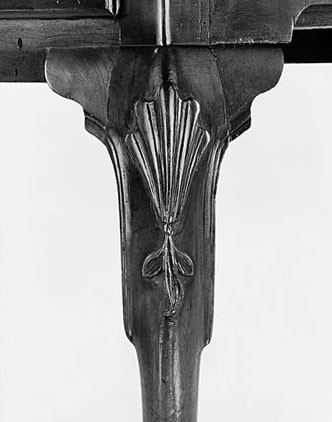
Detail of a carved knee from the table illustrated in fig. 11.
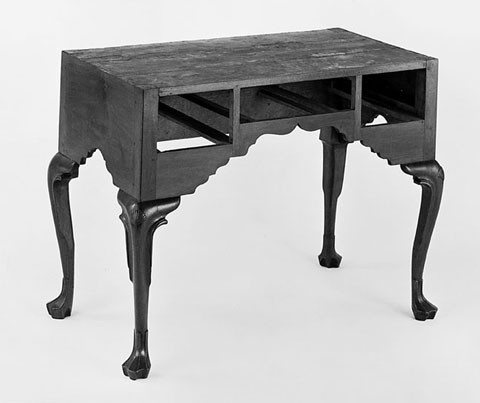
Base of a high chest of drawers, Rappahannock River basin, Virginia, 1745–1760. Black walnut with yellow pine. H. 31", W. 41 1/2", D. 23". (Courtesy, Colonial Williamsburg Foundation; photo, Hans Lorenz.)
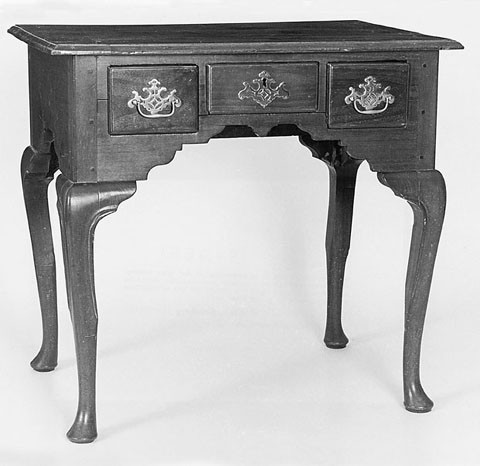
Dressing table, Rappahannock River basin, Virginia, 1745–1760. Black walnut with yellow pine. H. 28 1/2", W. 29 7/8", D. 20 7/8". (Collection of the Museum of Early Southern Decorative Arts, gift of Mr. and Mrs. Thomas S. Douglas, III.)
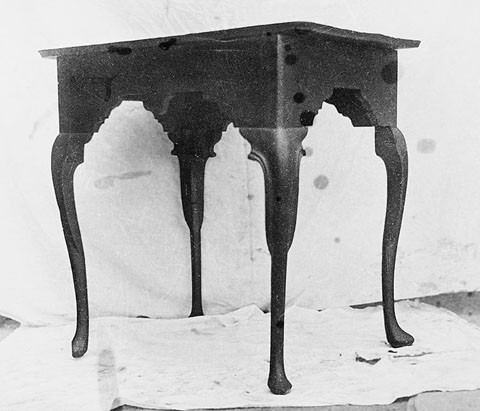
Tea table, Rappahannock River basin, Virginia, 1745–1760. Woods and dimensions not recorded. (Courtesy, Colonial Williamsburg Foundation; photo, J. K. Beard collection, ca. 1935.)
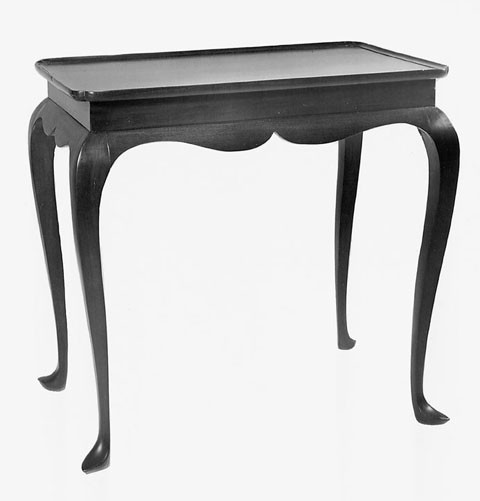
Tea table, Ireland, 1740–1770. Mahogany with deal. Dimensions not recorded. (Private collection; courtesy, Glin Castle Irish Furniture Archive.)

Tea table, Rappahannock River basin, 1755–1770. Black walnut. H. 28 1/2", W. 38 1/4", D. 22 3/4". (Private collection; photo, Hans Lorenz.)
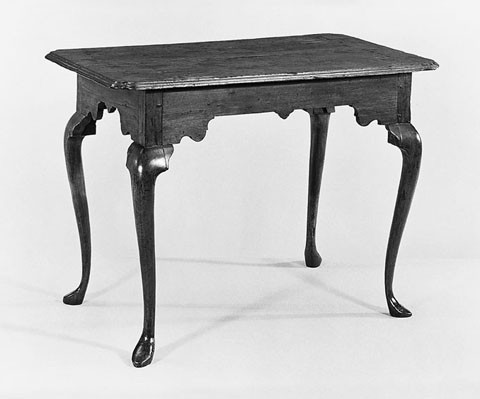
Tea table, Rappahannock River basin, 1755–1770. Black walnut. H. 29", W. 38 3/4", D. 23 5/8". (Courtesy, Colonial Williamsburg Foundation.)

Tea table, Ireland, 1735–1750. European walnut with deal and other woods. Dimensions not recorded. (Private collection; courtesy, Glin Castle Irish Furniture Archive.) This table was found at Newbridge, County Dublin.
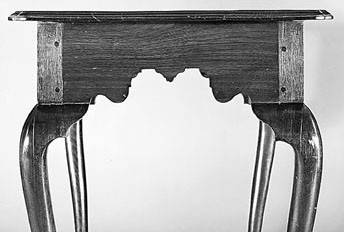
Detail of an end rail from the tea table illustrated in fig. 20.

Tea table, Ireland, 1750–1760. Mahogany. H. 30", W. 30", D. 21". (Courtesy, Malahide Castle, Ron and Doreen McDonnell Collection; photo, Gavin Ashworth.)
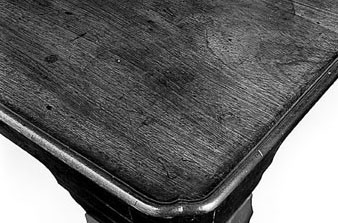
Detail of a corner on the top of the tea table illustrated in fig. 24. (Photo, Gavin Ashworth.)

Detail of a corner on the top of the tea table illustrated in fig. 20.
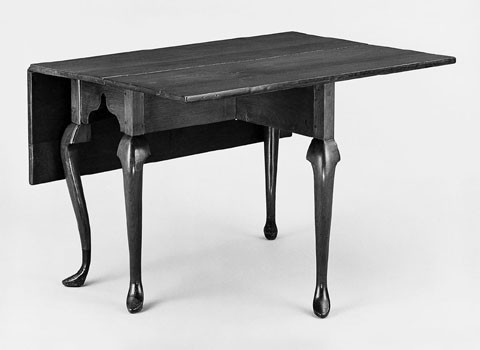
Dining table, Rappahannock River basin, 1755–1770. Black walnut with yellow pine. H. 29 1/4", W. 44 3/4", D. (closed) 17", D. 46 1/8" (open). (Courtesy, Colonial Williamsburg Foundation; photo, Hans Lorenz.)
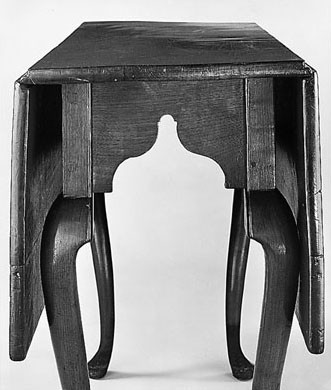
Detail of an end rail from the dining table illustrated in fig. 27.
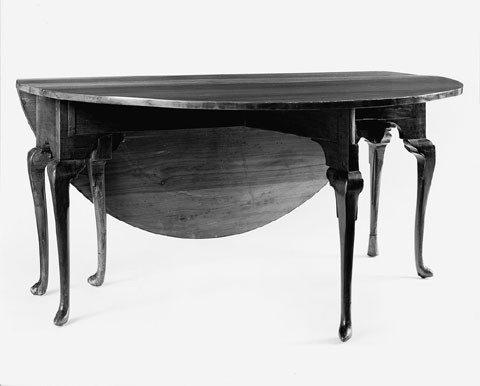
Dining table, Rappahannock River basin, 1755–1770. Black walnut with yellow pine. H. 28 1/2". (Private collection; photo, Gavin Ashworth.) The top is replaced.
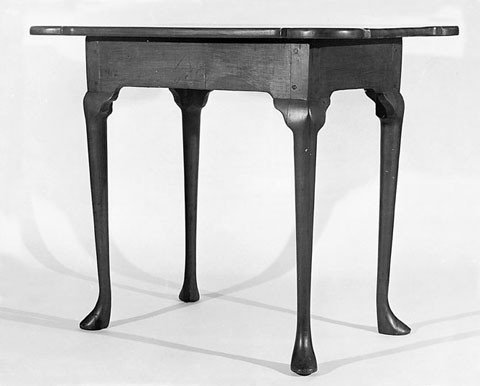
Tea table, Rappahannock River basin, 1750–1760. Mahogany. H. 26 1/2", W. 24", D. 16 1/2" (all dimensions are from the frame). (Private collection; photo, Museum of Early Southern Decorative Arts.) The top is replaced.
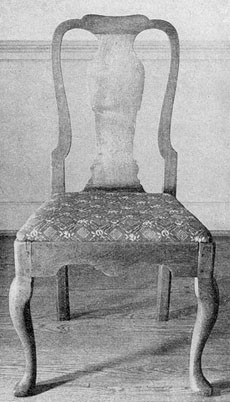
Side chair, Rappahannock River basin, 1745–1760. Black walnut. H. 39". (Private collection; photo, Antiques 61, no. 1 [January 1952]: 66, fig. 48.)
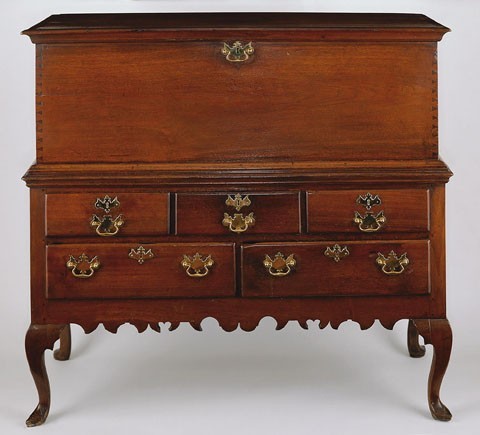
Chest on stand, Rappahannock River basin, 1750–1765. Black walnut with yellow pine, tulip poplar, and oak. H. 46 1/2", W. 50 5/8", D. 20 1/8". (Private collection; photo, Gavin Ashworth.)

Chest on stand, Ireland, 1740–1760. Mahogany. H. 41", W. 47", D. 25". (Private collection; courtesy, Sotheby’s.)
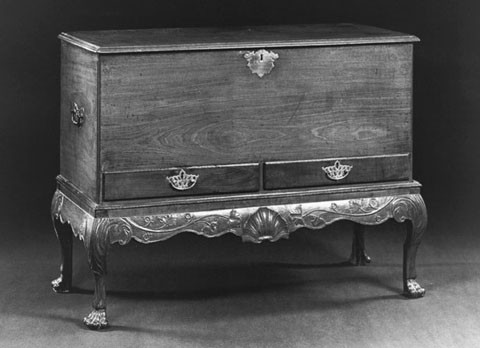
Chest on stand, Ireland, 1740–1760. Mahogany. H. 39", W. 51", D. 35". (Private collection; courtesy, Sotheby’s.)
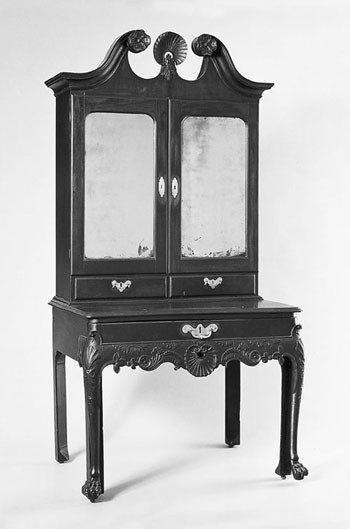
Writing table and bookcase, Ireland, 1740–1760. Mahogany with oak. H. 83 1/4", W. 34 3/4", D. 30". (Courtesy, Colonial Williamsburg Foundation, gift of Hiram J. Halle; photo, Hans Lorenz.)

Armchair, Rappahannock River basin, ca. 1765. Mahogany with white pine (by microanalysis). Dimensions not recorded. The splat is an old replacement. (Private collection; photo, Gavin Ashworth.)
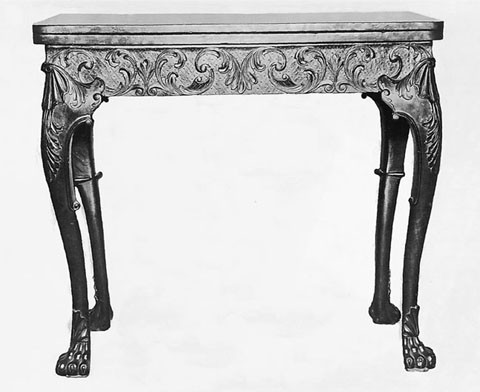
Card table, Ireland, 1750–1765. Mahogany. Dimensions not recorded. (Private collection; courtesy, Glin Castle Irish Furniture Archive.)
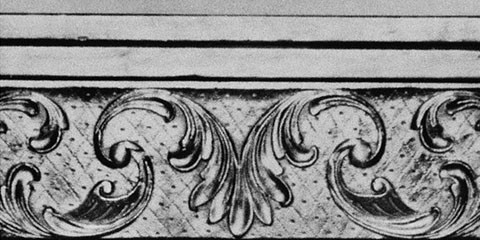
Detail of the front rail carving on the card table illustrated in fig. 37.
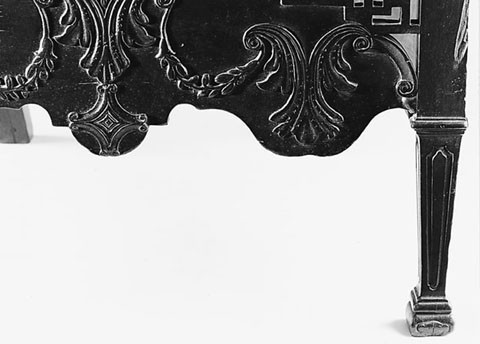
Detail of the front apron carving on the armchair illustrated in fig. 36.
During the last twenty-five years, research has dramatically increased our understanding of the furniture trade in eighteenth-century Tidewater Virginia. In the course of this work, scholars have rightly looked to contemporary England as the main source of stylistic and structural detailing in Tidewater furniture, a pattern that mirrors the Anglocentric focus of many southern historians. Because England was the dominant economic and cultural force in the eastern part of the colony, the elite routinely ordered cabinetwares from London, Liverpool, and other English ports until the outbreak of the Revolution. An even greater impact on eastern Virginia’s furniture industry came from the significant numbers of English joiners and cabinetmakers who emigrated to the towns and rural districts of the coastal plain during the second and third quarters of the century. These transplanted artisans continued to make vast quantities of furniture in the English taste, and they trained hundreds of Virginia-born apprentices to carry on the same traditions.[1]
Perhaps because of England’s preeminent role in the development of the Virginia furniture industry, little attention has been given to the role played by immigrant cabinetmakers from other parts of the British Isles. The dearth of published information about the furniture of Ireland, Scotland, and Wales has certainly hindered such research. However, as furniture historians on both sides of the Atlantic have begun to identify specific Irish, Scottish, and Welsh cabinetmaking traditions, it has become apparent that artisans from those places did shape some localized cabinetmaking practices in Virginia and the other southern colonies. One of the clearest examples of this phenomenon is found in the lower Rappahannock River basin, where a remarkable body of cabinetwares made in several shops from the 1750s to the 1770s exhibits strong evidence of Irish design influence.[2]
Almost entirely rural in the eighteenth century, the narrow peninsulas on both sides of the Rappahannock River supported a mix of small and middling farms and sizable plantations (fig. 1). The landowners grew tobacco and, later, grain for export to Europe and the West Indies. Ships from British ports commonly sailed directly to local river landings where they off-loaded imported manufactured goods and took on cash crops in return. Considerable commercial activity also occurred in Fredericksburg at the falls of the Rappahannock. The area’s largest market center, it had a population of about fifteen hundred by 1775. Much smaller but still important to local commerce were the villages of Port Royal in Caroline County and Tappahannock in Essex County, each with an estimated population of a few hundred.[3]
Structural and stylistic analysis indicates that Irish-influenced furniture from the Rappahannock basin was made in three or more shops. The exact locations of these businesses are unknown, but Tappahannock is the best candidate since much of the furniture in question was originally owned within the adjacent counties of Essex and Richmond. Despite its small size, Tappahannock was an official port of entry where as many as a half-dozen ships were commonly anchored. The town had a Masonic Lodge, an impressive brick courthouse, a room for public balls or “assemblies,” and a number of gentry residences. Cabinetmaker John Nesmith is known to have worked in Tappahannock from 1778 to 1789, and there were almost certainly others. On the other hand, some of the furniture in this study may have been made in nearby rural shops. Between 1730 and 1790, the counties of Essex and Richmond alone were home to at least ten artisans who called themselves cabinetmakers. Some of these tradesmen probably made furniture during the winter months but farmed during the spring, summer, and fall.[4]
The most obvious evidence of Irish influences on Rappahannock cabinetwares is found in the local popularity of several standard Irish foot forms, including one that Irish furniture historians term the trifid foot. Not to be confused with the American interpretation of that word, the Irish trifid features a large, rounded central lobe flanked by a pair of small, tightly scrolled volutes. Only occasionally encountered in England, the trifid was one of the two or three most widely used foot forms in Ireland from the 1720s to the 1780s. Trifid feet could be plain or exuberantly carved, depending on the overall ornamentation of the object, but the voluted form remained relatively constant. A representative example of the Irish trifid foot appears on the card table illustrated in figures 2 and 3. This foot is remarkably similar to those on a set of side chairs made in the lower Rappahannock basin during the 1760s or 1770s (figs. 4, 5). Originally upholstered over-the-rail, the chairs descended in the Beverley family of Blandfield plantation in Essex County. Outside the Rappahannock basin, the scrolled trifid foot is unknown in Virginia, and it is rare in other American centers except for Philadelphia, where the form was employed thirty to forty years earlier.[5]
The same Rappahannock shop that made the trifid-foot chairs also made furniture with paneled feet, to use the current Irish term. Examples include a second set of side chairs with a history in the Beverley family (figs. 6, 7) and a corner chair originally owned by the Garnett family at Peach Grove plantation in King and Queen County about fifteen miles from Tappahannock (fig. 8). All of these chairs have splats cut from the same template, and all were made of cherry, one of the area’s most popular primary woods. The paneled feet on the Beverley and Garnett chairs nearly match those on a circa 1750 game table at Glin Castle in County Limerick (figs. 9, 10). Found on hundreds of other surviving Irish tables and chairs, the paneled format was easily the most common Irish foot form of the day. Again rare in English furniture, its scattered appearance in American cabinet centers such as Philadelphia is usually associated with the presence of immigrant Irish artisans.[6]
The dressing or writing table shown in figure 11 also appears to be from a contemporary Rappahannock shop. The paneled feet, while not identical, are quite similar to those on the Beverley and Garnett chairs. Although the early history of the table is unknown, it features important structural characteristics associated with eastern Virginia furniture. In particular, the thin knee blocks are glued directly to the front of the rails, an English technique transplanted to parts of the coastal South (fig. 12). The knee blocks on tables and chairs from other American cabinet centers, including those in the Delaware Valley, generally are much heavier and are glued and nailed to the underside of the rails. Contemporary, single-drawer Irish tables akin to the Rappahannock example survive in large numbers (fig. 13). Their cabriole legs frequently have elongated, carved scallop shells and pendant leaves flanked by pairs of partial knee scrolls, a particularly popular combination in Ireland (figs. 14, 15). Similar ornament appears on the tables illustrated in figures 2, 22, and 24. The pairing of a straight front apron with slightly shaped side aprons also parallels Irish precedent. Although many of these individual details can be found on English furniture, their combined use here argues for an Irish design source.
Representing the work of a different Rappahannock shop, but similarly Irish influenced, are the remains of a high chest of drawers that descended in the Finch family of King George County, across the river from northern Essex (fig. 16). The chest has lost its upper case and its lower drawers. The drawer supports were incorrectly replaced during the 1950s when the knee blocks and the center section of the front rail were conjecturally restored. Despite its poor condition, the object still speaks to its cultural origins. In particular, its heavily articulated paneled feet and the pronounced, deeply molded partial knee scrolls that end abruptly above the ankle suggest strong ties to Irish furnituremaking traditions. In addition to these ornamental details, the mere presence of a high chest of drawers in colonial eastern Virginia points toward an Irish connection. Only two Tidewater high chests survive—both in fragmentary condition. The form was considered old-fashioned in English urban centers by the 1720s or 1730s and was succeeded by case forms such as the clothespress. Most middling and gentry householders in coastal Virginia willingly followed the English lead, as demonstrated by the large number of Virginia clothespresses that survive. The high chest, however, remained in production in Irish cities as late as the 1780s, which probably accounts for its late appearance in the Rappahannock basin.[7]
The dressing table illustrated in figure 17 is from the same shop that produced the Finch high chest. Although it stands on simply turned pad feet and lacks the diminutive, carved scallop shell on the knee, the cabriole legs exhibit deeply molded partial knee scrolls identical to those on the high chest. Other parallels are found in the similarly shaped side and front rails and the construction of the side and back panels, the latter identical down to the placement of the triple joint pins. Fragments of the original drawer supports in the high chest suggest that they matched those in the dressing table. The table has long been attributed to Williamsburg because of its discovery in the Wornom family of nearby York County in the 1930s, but a recent survey of early Virginia tax, census, and court records reveals that all identifiable members of the Wornom family lived in Northumberland County during the eighteenth century. Situated at the tip of Virginia’s Northern Neck, Northumberland shares its southwestern border with Richmond County, where a number of the objects in this study were first owned.[8]
A tea table recorded in the J. K. Beard photographic collection at Colonial Williamsburg may well be from the shop that produced the Finch and Wornom pieces (fig. 18). Until his death in 1940, Beard was Virginia’s most active and noted dealer in southern furniture. With a base of operations in the city of Richmond, forty miles southeast of Tappahannock, Beard’s early photographs confirm that he handled many of the most important pieces of southern furniture now in the region’s public and private collections. The boldly formed rectangular tea table illustrated in figure 18 was among the objects Beard owned in the 1920s or 1930s. Its cabriole legs and heavily molded partial knee scrolls are remarkably similar to those on the high chest and the dressing table, and its deep, shapely aprons are reminiscent of those on both pieces. The tea table features the so-called slipper foot, another typically Irish form. Widely popular in the lower Rappahannock basin, the slipper foot, again, is unknown in the rest of Virginia and rare elsewhere in America except for early eighteenth-century Philadelphia and New York and midcentury Newport, Rhode Island.[9]
Irish slipper-foot tables often have sparely ornamented but well-shaped cabriole legs like those on a table found in Dublin early in this century (fig. 19). Similarly conceived legs and feet appear on a group of Rappahannock tables from the third quarter of the eighteenth century, among them a tea table with a history in the Beverley family at Blandfield (fig. 20). An identical table by the same artisan was acquired by Colonial Williamsburg in 1928 from Bessie Brockwell, a Petersburg dealer in Virginia antiquities (fig. 21). Both tables exhibit simplified versions of the busily shaped aprons seen on many Irish tea tables (figs. 22-24), as well as the indented corners common to both Irish and English forms (figs. 25, 26). The artisan responsible for the two Rappahannock tea tables used the same foot and leg designs on a dining table with deep, well-shaped end rails (figs. 27, 28). Brockwell sold the latter table to the Colonial Williamsburg Foundation in 1932.[10]
Yet another Irish-influenced Rappahannock shop was responsible for a much larger dining table that descended in the Bates family of Essex County (fig. 29). Like the previous example, this piece has deep rails with shaped cut-outs at each end, and it stands on slipper feet. The frame and gate construction of the two dining tables is different, however, as are the details of their legs and feet. The cabriole legs on the Bates table are much straighter and stiffer than those on the tables shown in figures 20, 21, and 27, and the rear face of the slipper foot does not curve as sharply forward. A comparatively plain, mahogany tea table with a history at Sabine Hall plantation, the Richmond County estate of the Landon Carter family, may well be associated with the Bates piece (fig. 30). Below the abruptly shaped knees, the legs are almost perfectly straight, and there is only a trace of the forward curve behind the slipper foot. The porringer top on the table is a modern, and probably inaccurate, replacement.[11]
Only one set of Virginia-made slipper-foot chairs is known, but their execution in black walnut and their history in the prominent Chinn family of Tappahannock argue for production in the Rappahannock basin (fig. 31). Although the chairs were not available for examination and have not been publicly seen since the 1952 exhibition, “Southern Furniture,” at the Virginia Museum of Art, the minimally curved rear face of their feet points to a connection with the Bates and Carter family tables. The central drop on the front rail of the Chinn chairs is reminiscent of those on other Rappahannock furniture, including the Wornom dressing table, the Beard tea table, and the Beverley tea table (figs. 17, 18, 20).[12]
Evidence of Irish influence in the Rappahannock basin is not confined to individual details but also is seen in the presence of at least one typically Irish furniture form, the chest with drawers on cabriole stand. The example illustrated in figure 32, which descended in the Jeffreys family of Richmond County, stands on short cabriole legs with slipper feet similar to those on the Beverley tea table group. The chest on cabriole stand, only occasionally encountered in England and rare in America except in areas of Irish settlement, was one of the most frequently encountered case furniture forms in eighteenth-century Ireland. Irish examples more often have one tier of drawers instead of two, but variations in the stands are seemingly endless (fig. 33). Many feature carved and shaped skirts, which may be the inspiration for the extensively shaped front apron on the Jeffreys chest (figs. 32, 34). Two other southern chests feature double tiers of drawers, shaped aprons, cabriole legs, and slipper feet. Produced in a different shop, they are more coarsely constructed and probably later than the Jeffreys piece. Even so, they exhibit similar exposed dovetails and may well be from the Rappahannock basin.[13]
Most of the Irish-influenced furniture illustrated thus far fits into the eastern Virginia preference for cabinetwares in the neat and plain style. One of the hallmarks, however, of eighteenth-century Irish furniture is the abundance of shallow but florid carving that decorates the often deep aprons of tea, card, and sideboard tables, chest on stands, and some other kinds of case furniture (fig. 35). These heavily ornamented goods were primarily made for the Irish gentry and nobility and were quite costly. Though there is little evidence of such work in the Irish-influenced furniture of the Rappahannock basin, one exception survives in the form of an extraordinary armchair that descended in the Carter family at Sabine Hall in Richmond County (fig. 36).
The basic shape of the Carter chair reflects a standard and widely employed British design. Similar tapered legs with block feet appear in the third edition of Thomas Chippendale’s Gentleman and Cabinet-Maker’s Director (1762). The deep front and side aprons are also typical of close stool chairs, like this one, and were intended to conceal the tall, cylindrical chamber pot housed within. In an eastern Virginia context, however, the carving that is lavishly distributed over the aprons is without parallel. It lacks the background punchwork and/or diapering often seen on the fully carved aprons of Irish pieces, but the overall design of the carved ornament is quite close to that on a number of Irish tables. In particular, the symmetrical acanthus sprays with voluted terminals on the Carter chair are remarkably similar to those on the front apron of a midcentury Irish card table (figs. 37-39). The enormous wealth of the Carter family likely accounts for this uncharacteristically profuse display of carved ornament.[14]
As noted, many of the details observed on the furniture in this study also appear on contemporary English pieces; however, the elements in question—trifid, paneled, and slipper feet, pronounced knee scrolls, and the like—are seen only sporadically in England, where dozens of other ornamental options were far more popular. On the other hand, these designs, particularly the foot forms, were enormously popular in Ireland. That all of them appear together in the small geographic confines of the Rappahannock basin, but are found nowhere else in the Chesapeake, argues convincingly for the presence of an Irish connection.
The stylistic parallels between furniture attributed to the Rappahannock River basin and to Philadelphia also raise a question as to whether any of the pieces attributed to Virginia could have been made in Pennsylvania. Furniture was occasionally shipped to Virginia from Philadelphia, but for a variety of reasons the objects illustrated here do not fit that pattern. Although the trifid and paneled feet on the cherry chairs made for the Beverley and Garnett families (figs. 6, 8) are analogous to those from Philadelphia and other Delaware Valley centers, the scale of the Virginia chairs is smaller and more delicate than that of eastern Pennsylvania seating furniture. The through-tenons, nailed-on knee blocks, and vertical, quarter-round glue blocks common to Delaware Valley chairs do not appear on the Rappahannock examples. Moreover, the splat pattern on the Virginia pieces clearly places their date of production in the third quarter of the eighteenth century, well after the foot forms in question had largely disappeared from Philadelphia furniture. The same is true of the slipper-foot tea and dining tables. Use of the slipper foot was never widespread in the Delaware Valley, and it went out of fashion there before the Virginia tables were made. Although cherry was a popular primary wood in both eastern Pennsylvania and the Rappahannock River basin for much of the eighteenth century, the pithy, relatively poor-quality cherry that grew in the sandy soils along the Rappahannock is usually easy to distinguish from the hard, clear cherry grown in Pennsylvania’s loamy, rocky soils and cooler climate.
How, then, do we account for the presence of several Irish-influenced cabinet shops in the rural Rappahannock basin? The answer lies in the regular but little recognized trade relationships that existed between Ireland and the Chesapeake colonies for much of the eighteenth century, particularly between the 1720s and the 1770s. Irish linen, highly salable because of its consistent quality and competitive pricing, was the principal manufactured commodity in this trade. In fact, the Chesapeake was one of Ireland’s largest regional American markets for linen, a necessary commodity widely used in the fabrication of bedding and all grades of clothing. Most Irish cloth came to the Chesapeake on Irish ships and was sold directly to consumers along the Rappahannock and other rivers. Norfolk, Virginia’s largest port, also did a brisk trade in Irish linen, averaging nearly 157,000 yards per year between 1769 and 1772.[15]
Chesapeake exports to Ireland included tobacco, which was a staple in that trade for much of the eighteenth century, but as Maryland and Virginia planters began shifting to grain production in the 1750s, shipments of wheat also took on a central role. In 1768, more than 11,000 bushels of wheat were shipped to Irish ports from the upper district of the James River alone. Two years later, Virginia planters sent three times that amount to merchants in Ireland. Baltimore, an increasingly significant market center for Chesapeake planters as far south as the Rappahannock, played an even larger part in the Irish wheat and flour trade. In 1770, 102,000 bushels of wheat, or about 40 percent of Baltimore’s tonnage, was shipped directly to Ireland. Much of that grain came from Virginia farms and plantations.[16]
The healthy economic exchange between Ireland and the Chesapeake certainly fostered contacts that might have led to the immigration of Irish artisans, including cabinetmakers; however, an even more important factor in the arrival of Irish craftsmen was the staggeringly high trade in indentured servants, which continued unabated until the end of the eighteenth century. It is estimated that fifty thousand Irish immigrants came to America during the particularly intensive years between 1760 and 1775, and most arrived as indentured servants. By this time, indentured service no longer carried the stigma it once had but was instead seen as a practical means of securing passage to Britain’s American colonies. Because servants were in demand, the terms of indenture were often favorable for the “adventurer.” Except for convicts, service rarely exceeded four years, and contracts were no longer sold at auction on American docks; many Irish servants renegotiated their own contracts upon arrival in the colonies.[17]
During the last decades of the colonial period, America’s servant trade with Ireland was dominated by three immigrant Irish merchant communities: one in New York, another in Philadelphia, and the third in the thriving Chesapeake port of Baltimore. The volume in Baltimore was significant. In 1774, an Irish merchant living in the Maryland port wrote to an associate in Drogheda: “We are sure that within these two Years there has been 6000 servants sold in this Town from England and Ireland.” Although many indentured servants worked off their time in agricultural pursuits, during the 1760s a Philadelphia merchant wrote to a colleague in Ireland that “Tradesmen of all Sorts sells very high.” Records confirm that incoming Irish and other servants seldom stayed in the ports where they first landed. Their time, instead, was often purchased by individuals from other areas, who periodically went to cities like Baltimore in search of laborers.[18]
The nationality of immigrant cabinetmakers in the Chesapeake is often difficult to determine, even under the best of circumstances. With Irish artisans, this determination is complicated by the fact that Ireland was heavily colonized by the English in the seventeenth century so that, by the mid-eighteenth century, many native Irishmen bore English and other British surnames. It is known, however, that some Irish artisans who disembarked at Baltimore eventually moved south in search of opportunities. An example is cabinetmaker James McCormick, who arrived in Baltimore in 1785 or 1786 and advertised that he had “for some Years past worked in the first Shops in Dublin.” Within a few months, McCormick moved his business south to Alexandria, Virginia, on the Potomac River, and in time he relocated to Norfolk before finally settling in Petersburg.[19] Other Irish artisans clearly followed similar paths.
Traditional historians usually rely on surviving written documents to prove the theories advanced in their research, a luxury frequently unavailable to students of material culture. Even so, a close examination of three-dimensional objects and the context of their use and ownership can often provide the evidence needed to substantiate a theory or explain a seemingly abberant pattern. Such is the case with the cherry and walnut furniture made in the lower Rappahannock basin and the Irish cabinetmaking practices that shaped it.
ACKNOWLEDGMENTS
For their generous assistance, I wish to thank Luke Beckerdite at the Chipstone Foundation; Carey Howlett, Jonathan Prown, and Susan Shames at Colonial Williamsburg; Sally Gant and Martha Rowe at the Museum of Early Southern Decorative Arts; Paul Doyle and Mairead Dunlevy at the National Museum of Ireland; John Bivins; Anne Rogers Haley; and Sumpter Priddy. I am particularly grateful to Desmond Fitz-Gerald, Knight of Glin, who not only shared his own extensive knowledge of Irish furniture but opened the photographic archives at Glin Castle and arranged access to several important public and private collections of Irish furniture.
Clear evidence of Irish furniture design also has been observed in the piedmont region of North Carolina. See Michael H. Lewis, “American Vernacular Furniture and the North Carolina Backcountry,” Journal of Early Southern Decorative Arts 20, no. 2 (November 1994): 1–38.
For sample references to the Wornom family in Northumberland County, see T. L. C. Genealogy, Virginia in 1740: A Reconstructed Census (Miami Beach, Fl.: T. L. C. Genealogy; 1992), p. 305; Netti Schreiner-Yantis and Florene Speakman Love, comps., The 1787 Census of Virginia, 3 vols. (Springfield, Va.: Genealogical Books in Print, n.d.), 2:1270, 1998; and Government Printing Office, Heads of Families at the First Census of the United States taken in the Year 1790, Virginia (Washington, D.C., 1908), pp. 38, 75, 188. Despite the survival of York County records as far back as the 1630s, the earliest reference to the Wornom family in that jurisdiction is a marriage record in 1825. W. B. Crindlin, “York County Marriages,” Virginia Magazine of History and Biography 25 (December 1917): 420.
The city of Richmond, located in central Virginia on the James River, should not be confused with Richmond County on the Rappahannock River. The slipper foot also appears in the piedmont region of North Carolina, where other Irish-influenced furniture designs have been recorded. See Lewis, “American Furniture and the North Carolina Backcountry,” pp. 29–33. For an example of a Philadelphia slipper foot, see Downs, American Furniture, no. 112. For a Newport slipper-foot high chest of drawers dated 1748, see Brock Jobe and Myrna Kaye, New England Furniture: The Colonial Era (Boston: Houghton Mifflin Co., 1984), p. 34, fig. I–38.
The Chinn chair was illustrated in Helen Comstock, “Furniture of Virginia, North Carolina, Georgia, and Kentucky,” Antiques 61, no. 1 (January 1952): 66, fig. 48. The inverted baluster-form splat, rare in Virginia, is similar to those on a set of black walnut chairs originally owned by the Tayloe family at Mount Airy plantation, directly across the river from Tappahannock. MESDA research files S-5422, 6057, and 7080. Initial testing suggested that one of the Tayloe chairs was made of European walnut, but it is now believed that all of these chairs are of American black walnut.
Truxes, Irish-American Trade, pp. 123, 141.
